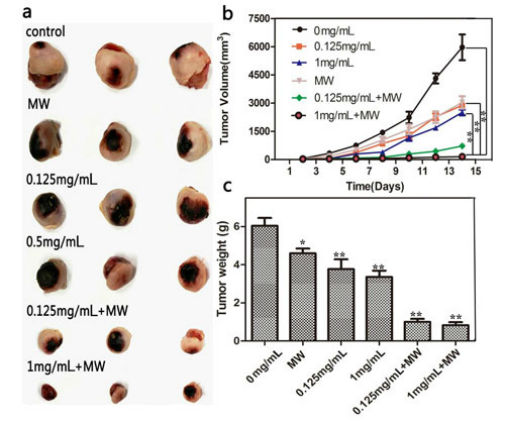|
NOVIDADES
The use of TiO2 nanoparticles activated by light and ultrasound has been studied extensively for cancer treatments. For the first time, researchers have shown the nanoparticles can be effectively activated by microwaves for cancer cell destruction – potentially opening new doors for patients fighting cancer. In a paper recently published in Nanomedicine: Nanotechnology, Biology and Medicine ("Exploration of TiO2 nanoparticle mediated microdynamic therapy on cancer treatment"), an international team of researchers has proposed the use of microwaves and TiO2 nanoparticles to induce the production of reactive oxygen species (ROS), which has the potential to be a safer, more effective modality for cancer treatment. The microwave-induced radical therapy, which the team has defined as microdynamic therapy (MDT), exploits the higher concentration of ROS in tumor cells to selectively trigger the death of cancer cells without causing significant harm to normal cells. The researchers hail from The University of Texas at Arlington (Wei Chen’s group), the Guangdong Academy of Medical Sciences (Yu Zhang’s group) and Beihang University (Junying Zhang’s group). The team conducted in vitro and in vivo experiments that demonstrate the nanoparticles can significantly suppress the growth of osteosarcomas under microwave irradiation. Traditional microwave therapy heats the cancer cells to trigger cell death, but it is difficult to singularly target the cancer cells without negatively affecting healthy cells. With the addition of the TiO2 nanoparticles to trigger the production of ROS, the researchers reduced the heating effects of the microwaves and increased the oxidative effects to kill cancer cells without damaging surrounding healthy tissue. Intracellular ROS are able to damage plasma membranes, mitochondria and DNA, causing cell death. TiO2 enters cells and produces ROS to damage the mitochondria of cancer cells, leading to apoptosis. Normal cells have a lower steady-state saturation of ROS than cancer cells, so researchers are able to introduce increased levels of ROS to kill cancer cells without pushing normal cells to a critical level.  The size (a), volume (b) and weight (c) of tumors in different treatment groups on day 14 of the in vivo evaluations. Tumors treated with a combination of TiO2 nanoparticles and microwaves (0.125mg/mL+MW and 1mg/mL+MW), rather than just microwaves (MW) or just the nanoparticles (0.125mg/mL and 0.5 mg/mL) were consistently smaller in size.
The use of light for the activation of ROS, such as in photodynamic therapy, can be challenging for the treatment of tumors deeply located within the body. Microwaves, however, lend the ability to create deeper penetration that propagates through all types of tissues and non-metallic materials. The results of the pilot study indicate MDT is a promising approach for cancer treatment even though the method is just at the beginning and limitations are still being explored. The research team – comprised of Xiao Chu, Liang Mao, Omar Johnson, Kang Li, Jonathan Phan, Qingqui Yin, Lihua Li, Junying Zhang, Wei Chen and Yu Zhang – is next turning its attention to understanding the physics and internal mechanisms behind the powerful combination of microwaves and TiO2 nanoparticles. By Dana Jennings, University of Texas at Arlington. Accessed: June 03, 2019. |
|||||||||||||||||||||||||